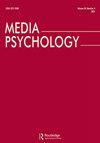注意信息鸿沟:Instagram的敏感内容屏幕在提供有关内容的信息时,更有可能阻止人们观看潜在的令人痛苦的内容
IF 2.6
2区 心理学
Q1 COMMUNICATION
引用次数: 2
摘要
本文章由计算机程序翻译,如有差异,请以英文原文为准。
Mind the Information-Gap: Instagram’s Sensitive-Content Screens are More Likely to Deter People from Viewing Potentially Distressing Content When They Provide Information About the Content
ABSTRACT Instagram’s sensitive-content screens seek to minimize engagement with negative content by blurring sensitive images and providing a warning. However, the very design of sensitive-content screens may elicit uncertainty/curiosity and prompt information-seeking behaviors: congruent with the information-gap hypothesis. To test this idea experimentally, we presented participants with screened negative images accompanied by a brief, detailed, or no content description, during a simulated Instagram task. Participants viewed screens one at a time and uncovered at their discretion. In line with our predictions, people uncovered screens irrespective of description type, but did so most often with no description. Most participants indicated that knowing what the sensitive content contained bolstered their ability to make an informed decision. These results have implications; information provided alongside sensitive-content screens can influence engagement and therefore should be considered as part of sensitive-content guidelines.
求助全文
通过发布文献求助,成功后即可免费获取论文全文。
去求助
来源期刊

Media Psychology
Multiple-
CiteScore
8.60
自引率
7.10%
发文量
30
期刊介绍:
Media Psychology is an interdisciplinary journal devoted to publishing theoretically-oriented empirical research that is at the intersection of psychology and media communication. These topics include media uses, processes, and effects. Such research is already well represented in mainstream journals in psychology and communication, but its publication is dispersed across many sources. Therefore, scholars working on common issues and problems in various disciplines often cannot fully utilize the contributions of kindred spirits in cognate disciplines.
 求助内容:
求助内容: 应助结果提醒方式:
应助结果提醒方式:


